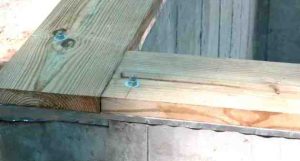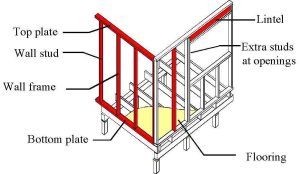Whether it’s a home or another structure, two essential components play pivotal roles: the sill plate and the bottom plate.
These components can seem similar at first glance. But they serve distinct purposes and vary in several key aspects.
So, what’s different in the Sill plate vs Bottom Plate?
Sill plates are located at the base of exterior walls, transferring loads to the foundation. On the contrary, bottom plates stabilize interior walls.
Sill plates face exposure to moisture and require termite protection, whereas, bottom plates are less exposed to moisture, and don’t need termite safeguards. Bottom plates are also easier to access and replace compared to sill plates.
I’ll delve into these differences to help you understand the unique roles that the sill plate and bottom plate play in construction. Let’s begin:
Sill Plate vs Bottom Plate: Key Differences
We’ll start off by taking a quick glance at the differences between sill plate and bottom plate:
| Aspects | Sill Plate | Bottom Plate |
| Location | Located at the base of exterior walls | Located at the bottom of the interior walls. |
| Application | Supports window | Connects the wall to the floor. |
| Purpose | Acts as a foundation connection | Provides stability to wall framing. |
| Material | Treated wood | Standard Lumber. |
| Load Bearing | Transfers load from walls to the foundation | Supports the weight of the wall above. |
| Anchoring | Often secured to the foundation with anchor bolts | Typically secured to the floor joists or subfloor. |
| Size | Wider | Narrower. |
| Exposure to Moisture | More | Less. |
| Termite infestation | More | Less. |
| Maintenance | Challenging | Easier. |
Note that sill plate also comes in two varieties: 2×6 and 2×8 in size. The 2×6 and 2×8 sill plates have differences between them. But both of them act similarly when compared with bottom plates.
Now that we’re familiar with the core differences of the two different types of plate, let’s learn them in detail:
Aspect 1: Location
The sill plate is located at the base of the exterior walls. It serves as the point of connection between the wall framing and the foundation.
Bottom plates, on the other hand, are located at the bottom of interior walls. They provide stability to the wall framing within the structure.
Now, bottom plates are often incorrectly referred to as sill plates. But they are actually called sole plates.

Aspect 2: Material
Due to exposure to exterior elements, sill plate materials are typically constructed from treated wood. This treatment helps protect them from moisture and decay, making them last long and stand against the harshest weather.
Standard lumber is often used to make bottom plates. Thanks to being located indoors, and hence don’t face much threat of exposure to moisture.
Aspect 3: Purpose
The primary role of the sill plate is to transfer the load from the walls to the foundation. It ensures that the weight of the structure is adequately supported and distributed.
Bottom plates provide stability to the wall framing within the interior of the structure, keeping it upright and aligned.
Aspect 4: Load Bearing
Sill plates are critical for bearing and transferring the loads from the walls above to the foundation. They must be durable and strong enough to be able to withstand considerable pressure.
While bottom plates support the weight of the wall above, they are not subject to the same level of load-bearing as sill plates.
Aspect 5: Exposure to Moisture and Termite
Sill plates are more exposed to exterior elements compared to bottom plates, making them susceptible to moisture. As a result, they often require moisture-resistant treatment or materials.
No products found.
Due to their exterior location, sill plates are also prone to termite infestation, requiring termite-resistant materials for the plate.
No products found.
Bottom plates are generally less exposed to moisture since they are located indoors. They also are less likely to experience termite infestation.
So you don’t need to put much effort into making bottom plates either moisture or termite-resistant.
Aspect 6: Anchoring
Sill plates are often secured to the foundation using anchor bolts or other means to ensure a strong connection between the walls and the foundation.
No products found.
Bottom plates are typically secured to the floor joists or subfloor, providing stability to the interior walls. They are installed face-down on the bottom of a wall.
The bottom plate anchor bolt spacing must be a maximum of 1.2 m centers. Moreover, it should no more than 150 mm from each end of every plate.
Aspect 7: Size
Sill plates are wider in dimension, covering the width of the exterior wall. This width allows them to distribute loads effectively throughout the exterior wall.
In modern wood construction, sill plate size usually rounds up around 2×4, 2×6, 2×8, and 2×10.
Bottom plates tend to be narrower in dimension, matching the width of the wall studs they support.

Aspect 8: Insulation
Sill plate insulation is not that important and doesn’t interfere with wall insulation. It’s because they are located on the exterior side of the wall.
Insulation is typically not directly applied to the sill plate itself. Instead, insulation is placed between the wall studs, above the sill plate, and within the wall cavity.
The primary reason is to prevent heat loss through the wall. However, the sill plate plays a role in sealing the bottom of the wall. It should be properly sealed to prevent air infiltration and enhance insulation effectiveness.
Bottom plates can require additional measures to accommodate wall insulation because they are located on the interior side of the wall.
Aspect 9: Sealing
Again, sill plates require sealing primarily because they are located at the base of exterior walls, making them vulnerable to air and moisture infiltration from the outside.
Proper sealing of the sill plate helps prevent drafts, moisture, and pests from entering the living space.
No products found.
In contrast, bottom plates are usually within the interior of a building. Here the temperature and humidity are more controlled. So, sealing is not as critical for them in most cases.
However, sealing is still essential for all construction components to maintain energy efficiency and prevent air leaks.
Aspect 10: Maintenance
Bottom plates typically have easier maintenance compared to sill plates. This is because bottom plates are located within the interior of a building, making them readily accessible for inspection and maintenance if necessary.
Unlike bottom plates, sill plates are located at the base of exterior walls, often close to the foundation, which can make their inspection and maintenance more challenging and labor-intensive. This also makes replacement difficult for sill plates.
FAQs
How thick is the sill plate?
Sill plates must have a minimum thickness of 2 inches to be durable enough.
What goes under sill plate?
A sill sealer, also known as sill gasket is a foam product goes under the sill plate to air seal it. It’s laid over the concrete before laying down the sill plate.
What material is a bottom plate?
Although bottom plates mostly use standard lumbers, other materials such as steel, concrete, or other composite materials can also be used for bottom plates.
Final Words
That’s all you need to know about sill plate vs bottom plate.
Keep in mind that the specific requirements for the plates can vary in different regions depending on the local building codes. So before you jump into building your houses, make sure to take a quick look at the regulations.
Cheers.
- 2×6 or 2×8 Sill Plate (Which One is Better for Foundation) - September 3, 2023
- Sill Plate vs Bottom Plate (What’s the Difference) - August 31, 2023
- Craftsman Chainsaw Carburetor Diagram (2023) - June 12, 2023
